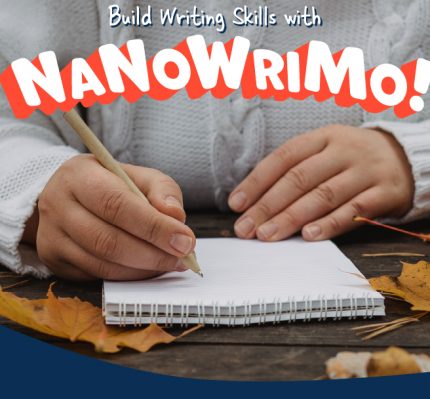What’s so great about November? It’s National Novel Writing Month (NaNoWriMo)! Back in 1999, a challenge was issued for creative writers to write 50,000 words of a new novel during the thirty days of November. Since then, nearly half a million adults and young writers have answered the call. And November has become a time for inspiration and creativity. Is this something you can use in your homeschool? You bet!
Continue reading to discover more about NaNoWriMo and how it can be used in your homeschool to motivate your children and build their writing skills.
What is NaNoWriMo?
NaNoWriMo is both an Internet writing competition and a nonprofit organization that supports creative writers all year round! During November, it hosts well-known authors who write pep talks to keep creative writers motivated. It shares advice for making it through the month and tips from a NaNoWriMo camp winner. NaNoWriMo offers help with tracking progress and setting goals and milestones. It also features events that help you meet your goals. You can even connect with other writers through forums and other social networking—like a Facebook for writers!
Throughout the year, NaNoWriMo offers monthly NaNoWriMo writing camps and advice through its blog and encourages volunteers to organize communal writing groups. Since NaNoWriMo began, hundreds of thousands of writers have taken part in challenges, programs, projects, and volunteering. Best of all, everything NaNoWriMo offers is free!
How Can You Use NaNoWriMo to Build Creative Writing Skills?
What can you do with NaNoWriMo in your homeschool? The possibilities are endless, but NaNoWriMo has made it easy with its NaNo Prep 101 workshop. If you start ahead of time, you can use the curriculum as a six-week preparation guide to take part in November’s challenge. If you are starting late—no worries. You can download the entire NaNo Prep 101 workshop curriculum and use it as you like! Enjoy weekly exercises and lots of links to additional resources.
Besides the Nano Prep 101 workshop, here are some other ideas for using NaNoWriMo resources in your homeschool:
- Use individual exercises from the workshop or website as prompts for journal writing.
- Have your child participate in the NaNoWriMo challenge through the Young Writers Program, which supports writers under the age of 18.
- Incorporate videos from the NaNoWriMo YouTube Channel into your language arts instruction.
- Use the well-known writer pep talks as virtual “author visits.” Check out each author’s website (maybe even enjoy a book) and then read his or her thoughts on being a fiction writer.
- Have your child participate in curriculum-related community threads or join some Young Writers Program forums to get connected with other fiction writers.
How Can Creative Writing Help with Writing Essays?
Your child may love writing creative fiction, but how does that help when you ask them to write a five-paragraph essay comparing two works of literature? The good news is that creative writing builds skills that will also benefit academic writing. The best part is that students who write creatively often feel less anxiety about writing for school. The similarities can boost the confidence of the young writer.
These are just some academic writing skills and strategies that your child develops while writing creatively:
- Brainstorming: Creative writers must brainstorm ideas just like academic writers. Some strategies can overlap—like freewriting.
- Organizing Thoughts: Both creative and academic writers need to organize their thoughts. Sometimes creative writing can be even more difficult to organize because your child is so passionate about each of the ideas. You’ll find organizational strategies, like outlining and using graphic organizers, in both types of writing.
- Writing Structure: All writers need to adhere to the rules of writing structure. And both creative and academic writers have structures to follow. For example, both types of writers must determine when to break into a new paragraph. While academic writers must follow more formal paragraph structures, they can learn about connecting ideas, logical progression, and purposeful breaks through fiction writing.
- Description/Details: Many language arts teachers complain that academic writers do not give enough detail. Creative writing can help with that! Creative writers build description skills while bringing settings, people, and objects to life. This is great practice for being detail-oriented in essays.
- Revision/Editing: One of the greatest benefits of creative writing is that your child will understand the need for the revision process. Creative writers do drafts and revisions all the time. They also write with the thought of sharing or publishing, so editing becomes part of the natural writing process. While creative writers can bend conventional language rules through “poetic license,” they need to know the rules in order to bend them!
Creative writing can motivate even hesitant or anxious writers to enjoy expressing themselves through writing. Take advantage of the challenges, resources, and networking of NaNoWriMo to help your child become a better and more motivated writer this year!
Latest Posts

While nearly every college and university today is eager to accept homeschooled students into their institutions, homeschooling families need to understand that their student’s application…
Read more >
Guest Post by Gabriel Morse For several years, I sat for long hours every day behind one of those battleship gray desks in a windowless, dull, gray office. The pay was enough to take care…
Read more >
This post is sponsored by Little Monsters Universe. I'm Tina Salmanowitz, an advocate for homeschooling and science education. With over a decade of experience as a science educator (in class…
Read more >


